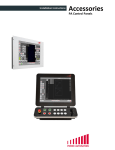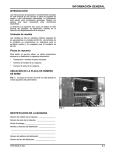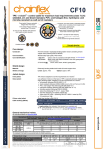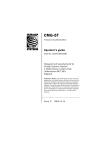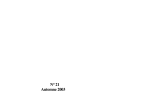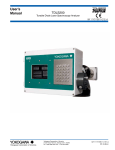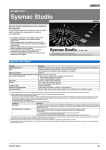Download Emerson 755A Specifications
Transcript
Installation and Wiring Guide 8 Precision Products For Every Application EPC World Headquarters Americas Division 464276 Highway 95 South P.O. Box 249 Sagle, ID 83860-0249 USA Phone: 800-366-5412 208-263-8541 Fax: 208-263-0541 E-mail: [email protected] Website: www.encoder.com EPC- Your Encoder Solutions Partner Company History Encoder Products Company Inc. (EPC) is a leading designer and world-wide manufacturer of motion sensing devices. Founded in 1969 by William Watt, EPC began operations with a small line of custom encoders. Today, more than 40 years later, EPC’s popular Accu-CoderTM brand is the most complete line of incremental and absolute shaft encoders in the industry. Our core philosophy is that each and every customer deserves quality products, superior customer service, and expert support. Leading The Industry By Innovation Concentrating specifically on encoders, we have paved the path of the encoder industry, providing many of the current encoder standards. Our industry leading advancements include the CubeTM style encoder, flex-mount system used on hollow-bore encoders, Opto-ASIC technology for enhanced signal quality, 120 C operating temperature for extreme environments, 6000 CPR in a 1.5" diameter encoder, a three year standard warranty, and many others. O Custom Encoders Our Specialty Through years of experience, we understand each industrial environment is different, and customize encoders for your specific situations. Many of our customers depend on EPC to provide encoders which fit their specifications, not someone else's. Using state of the art technology, we can design and deliver custom encoders faster than most suppliers standard products - often shipping your unique encoder in 2 to 6 days, or sooner. Plus, with ISO 9001:2008 quality systems, you will receive the quality you deserve. Table of Contents Warranty Information........................................................................... .1 Encoder Basics................................................................................... .2 Accessories......................................................................................... .3 Mounting and Mechanical Installation.................................................. 4 Recommended Bolt Torques................................................................ 5 Electrical Connection............................................................................ 6 Output Circuit Diagrams....................................................................... 8 Incremental Encoder Wiring Tables..................................................... 9 Absolute Encoder Wiring Tables..........................................................12 Troubleshooting....................................................................................13 Congratulations on your purchase of a genuine EPC Accu-CoderTM brand encoder. Every Accu-CoderTM is built to exact standards, and thoroughly tested during the manufacturing process. Improper installation is the major cause of most common problems. By following the guidelines given in this pamphlet, we hope to eliminate any problems before they start, thus providing the maximum life from your encoder. Properly installed and cared for, your Accu-CoderTM will give you years of trouble free use. Technical Bulletins, which provide general encoder information, and cover specific installations, can be found under the “Support” heading on www.encoder.com. If you have any questions concerning installation, please feel free to call Customer Service @ 1-800-366-5412. Thank you! WARRANTY INFORMATION Your Accu-CoderTM is guaranteed against defects in materials, and workmanship by the best three year standard warranty in the business. The warranty applies to all standard catalog products starting three years from the date of shipment. To learn more about our three year standard warranty, go to www.encoder.com, under the “Support” menu, select “Warranty.” 1 ENCODER BASICS Encoders provide motion control systems information on position, count, speed, and direction. As the encoder shaft rotates, output signals are produced, proportional to the distance (angle) of rotation. The signal may be in the form of a square wave (for an incremental encoder) or an absolute measure of position (for an absolute encoder). Due to the performance and reliability advantages of the semi-conductor technology they incorporate, optical encoders are the preferred solution in many common computer, industrial, and automotive applications. Optical encoders also benefit from ease of customization, are suitable to numerous environments, and suffer no effects from high levels of stray magnetic fields. The basic construction of an incremental encoder is shown to the right. A beam of light emitted from an LED passes through a transparent disk patterned with opaque lines, and is picked up by a photodiode array. The photodiode array (also called a photosensor) responds by producing a sinusoidal waveform which is transformed into a square wave, or pulse train. PHOTO SENSOR SQUARING CIRCUIT DISK LED Incremental encoders are available in two basic output types, single channel and quadrature. A single channel encoder, often called a tachometer, is normally used in systems that rotate in one direction only, and require simple position and velocity information. Quadrature encoders have dual channels (A and B), phased 90 electrical degrees apart. These two output signals determine the direction or rotation by detecting the leading or lagging signal in their phase relationship. Quadrature encoders provide very high speed bi-directional information for very complex motion control applications. Incremental encoders can provide a once-per-revolution pulse (often called index, marker, or reference) that occurs at the same mechanical point of encoder shaft revolution. This pulse is on a separate output channel (Z) from the signal channel or quadrature outputs. The index pulse is often used to position motion control applications to a known mechanical reference. Resolution is a term used to describe the Cycles Per Revolution (CPR) for incremental encoders, or the total number of unique positions per revolution for an absolute encoder. Each incremental encoder has a defined number of cycles that are generated for each full 360 degree revolution. These cycles are monitored by a counter or motion controller and converted to counts for position or velocity control. Absolute encoders generate a unique code word for every resolvable shaft angle (often called bits or counts per revolution). 2 ACCESSORIES Accessory items are often the difference between an installation that goes smoothly, and one that does not. EPC offers a range of accessories that are designed to not only make your life easier, but are manufactured to EPC’s high standards, ensuring years of trouble free service. In addition, they have been tested with the products they complement, so that you do not have to worry about proper form, fit, or function. Connectors/Cables High quality connectors, cables, cable assemblies, and cord sets selected to optimize encoder performance; most can be ordered with MS style or M12 connectors. Shaft Couplings Precision shaft couplings to optimize performance and reduce the chance of premature failure; designed to restrict the transfer of thermal and mechanical stress; wide range of choices to match your exact requirement. Call about our new Magnetic Coupling! Protective Covers Covers help protect encoders from damage. They also allow a wider variety of encoders to be used in harsh environments. Hub/Flanges Allow Accu-CoderTM encoders to be easily mounted to industry standard housing styles; NEMA, servo, 5PY, and other styles available; rugged, reliable construction. Mounting Brackets Used to mount measuring wheels to Cube and 702 Series Accu‑CodersTM. Two types: single pivot and dual pivot; single pivot pivots vertically while dual pivot pivots vertically and longitudinally. Measuring Wheels Used to obtain linear motion feedback from a rotating shaft; range of surface finishes (urethane, rubber, knurled, grooved) for proper mating to nearly any application surface; available in several sizes to allow you to satisfy your exact requirements. Linear Cable Adapter The linear cable adapter (LCA) used with a Cube Series standard or industrial housing, provides a low cost alternative for obtaining accurate linear measurement. 3 MOUNTING AND MECHANICAL INSTALLATION For over 40 years, our engineers have been designing encoders that are quick and easy to install. With a variety of mounting options available, your encoder should be a perfect match for your existing equipment. Accessories such as pivoting mounting brackets, measuring wheels, flexible couplings, etc., are available from EPC to ease installation. The first principle for every encoder installation is "Don't force it!". Striking or using excessive force can either damage your new encoder, or introduce excessive shaft loading, shaft misalignment, or other conditions shortening its expected life. Tighten all couplings and bolts to their recommended torque. Remember, tighter isn't always better! Shaft Style Encoders Hollow Bore Encoders • Gently couple the shaft of the Accu-CoderTM to the driving shaft, using a correctly sized flexible shaft coupling. Never use a rigid coupling. • Verify proper alignment between the Accu-CoderTM shaft and the driving shaft. • If using pulleys or gears, mount them on the shaft as close as possible to the Accu-CoderTM to reduce bearing load. • Axial and radial shaft loading should be low as possible. Never exceed printed specifications. • Use recommended torques to tighten all clamping bolts and couplings. C-Face Style Encoders 4 • Make sure driving shaft is free from burrs and other defects. • With flex mount flush against surface, tighten clamp or set screws first, then bolt flex mount to surface. • Check for best possible alignment with hollow shaft and driving shaft to reduce wobble. • Runout of the driving shaft, or misalignment between the driving shaft and the encoder’s hollow bore, decreases the accuracy and bearing life of the encoder and adds vibration to the system. Re-installing the encoder on the driving shaft may improve alignment. • Verify that mounting holes are in exact alignment with holes or studs on the motor frame. • Tighten all fasteners with equal torque so as not to distort the shape of the ring. Caution: Avoid damage to your Accu-CoderTM . The following actions may cause damage, and void product warranty. Do not shock or strike. Do not disassemble. Do not subject shaft to excessive axial or radial shaft stresses. Do not use a rigid coupling. RECOMMENDED BOLT TORQUES MODEL 15T/H 25T/H 225 260, 960 STYLE All Clamp All Clamp Flex Hollow 702 Flex Hollow Flex Hollow 755 Flex Hollow Collet 770 1.0” up to 1.375” 771 >1.375” to 1.875” Collet 775 Clamp Clamp 776 770, 775, 776 All 771 All All TR1, TR2 All TR1 All All TR2 All TR3 All DESC./LOCATION Set Screws / Shaft Clamp Bolt Set Screws / Shaft Clamp Bolt Set Screws / Shaft Clamp Bolt / Shaft Set Screws / Shaft Set Screws / 0.75” Shaft Cup / Cone Bolts Clamp Bolt Clamp Bolt Cup / Cone Bolts Clamp Bolt Clamp Bolt Protective Cover Protective Cover Pivot Bolt/Shaft Set Screw/Torque Adj Set Screw/Wheel Set Screw/Pinion Set Screw/Wheel Spring Pivot Clamp THREAD M3 6-32 6-32 2-56 6-32 4-40 6-32 4-40 4-40 8-32 6-32 4-40 8-32 6-32 4-40 3/8”-16 1/4”-20, M6 10-32 4-40 6-32 10-32 10-32 TORQUE 30 to 45 oz-in 10 to 15 lb-in 30 to 40 oz-in 100 to 120 oz-in 50 to 80 oz-in 115 to 160 oz-in 35 to 50 oz-in 25 to 40 oz-in 120 to 200 oz-in 30 to 35 lb-in 15 to 25 lb-in 120 to 200 oz-in 30 to 35 lb-in 15 to 25 lb-in 70 to 120 oz-in 180 to 240 lb-in 40 to 60 lb-in 15 to 18 lb-in 25 to 40 oz-in 35 to 50 oz-in 35 to 40 lb-in 30 to 35 lb-in HEX KEY 1.5 mm 7/64” 1/16” 5/64” 1/16” 3/32” 1/16” 0.050” 3/32” 9/64” 7/64” 3/32” 9/64” 7/64” 3/32” 5/16” 5/32” 3/32” 0.050” 1/16” 3/32” 5/32” 5 ELECTRICAL CONNECTION Proper wiring and grounding are essential for the longevity and proper operation of your Accu-CoderTM . In addition, electrical noise should be minimized to prevent improper counts and/or damage to the electronic components. Since an Accu-CoderTM can be used with a wide variety of input devices (PLC’s, counters, servo controllers, etc.), from many different manufacturers, it is important to determine proper wiring and connections before installation. Common Signals Most Accu-CoderTM encoders have the following electrical connections: Power, Common or Ground, and one or more Output Signals. Power (Also called supply, power source, encoder power, +V, or +VDC) • Always use a direct current (DC) voltage. • Attach power to the positive (+) side of the power source. • Verify that the Accu-CoderTM is receiving the proper voltage, since most electrical failures are caused by an improper or improperly regulated power source. • The use of surge protection is highly recommended. Common (Also called Com, supply common, and ground) • Attach common to the negative (-) side of the power source. Output Signals (Always at least one, but may be as many as six) • The most common are A, B, and Z. Commutation outputs include U, V, and W. • Encoders with a Line Driver output also have the complement (A and A’, B and B’, etc.) as separate outputs that are used to provide differential signals for reduced noise and greater drive capability. • Never connect the output signals together, or to the power source! Connections • Verify and match up pin numbers, wire colors, or terminal blocks with the input device. • Be aware that identification terminology may not always be identical. • Once proper wiring is determined, document it for future reference. Cable Routing • Cable length should be minimized by using the shortest route possible. • All cabling should be installed in dedicated metal conduits, or located at least 12” away from other wiring. • Route cables away from high current conductors to minimize pulses caused by electrical transients. • Signal wire continuity should be maintained from the encoder to the controller/counter. Avoid junctions and splices, if possible. 6 Radiated Electrical Noise • Noise can be generated by solenoids, relays, motors, starters, and similar devices. • Using shielded cables will dramatically reduce the effects of noise. Most Accu-CoderTM cables are double shielded (foil and braid) for optimum protection. • Ensure all equipment is properly grounded. (Motors, drives, shafts, etc.) • Connect encoder cable shield to ground at controller/counter end, leaving the end near the encoder unconnected. Connecting the shield at both ends can cause ground loops, and improper operation. • If possible, use differential line driver outputs with high quality shielded, twisted pair cable. (ComplementaryTypical signals greatly reduce common mode noise levels, as well Differential Line Driver Hook-up as signal distortion resulting from long cable lengths.) CONTROLLER OR COUNTERnoise. ENCODER • EPC’s line of+VDC Repeaters andTypical Converters may help reduce the effects of electrical Differential Line Driver Hook-up +VDC A ENCODER A’ Typical Electrical+VDC Hook-Ups COMMON A ENCODER Differential Line Driver Typical Differential Line Driver Hook-up CONTROLLER OR COUNTER +VDC CONTROLLER OR COUNTER +VDC A’ +VDC COMMON A A’ ENCODER ENCODER COMMON Typical Open Collector Hook-up +VDC Typical Open Collector Hook-up A +VDC COMMON A ENCODER ENCODER ENCODER Typical Open Collector Hook-up +VDC COMMON A COMMON ENCODER Open Collector +VDC A +VDC COMMON A +VDC COMMON A COMMON CONTROLLER OR COUNTER +VDC CONTROLLER OR COUNTER Pull-Up+VDC Resistor 500-2.2K OHM CONTROLLER OR or equivalent COUNTER Pull-Up+VDC Resistor 500-2.2K OHM or equivalent Typical Pull Up Resistor Hook-up Pull-Up Resistor 500-2.2K OHM or equivalent CONTROLLER OR COUNTER +VDC Typical Pull Up Resistor Hook-up CONTROLLER OR COUNTER +VDC Typical Pull Up Resistor Hook-up Pull-Up Resistor CONTROLLER OR COUNTER +VDC 7 Pull-Up Resistor 500-2.2K OHM or equivalent Output Circuit Diagrams Open Collector (O, OC, OD) +VDC LTR +VDC 2.2K OHM CONTROLLER OR COUNTER +VDC R LLER OR UNTER DC REVISIONS REVISIONS Pull-Up (S, PU) DESCRIPTION DESCRIPTION +VDC INITIAL RELEASE INITIAL RELEASE 1.5K OHM LTR OUTPUT OUTPUT OUTPUT COMMON COMMON OUTPUT COMMON Pull Collector Up Resistor2 Models 15T/H, 15S, 121, 225, 25T/H, Open COMMON Pull Up225, Resistor1 Models 711, 715-1, 260, 702, 711, 715-1, 715-2, 716 , 725, 755A, 758, 770, 771, 775, 776, 802S, 858S, 925, 958, 960, LCE, TR1, TR2 Pull Up Resistor2 Models 15T/H, 15S, 715-2, 716, LCE Line Driver (HV, H5) +VDC +VDC +VDC TOLERANCE 1.5K OHM +VDC 2.2K OHM 25T/H, 702, 725, 755A, 758, 770, 771, 775, 776, 802S, 858S, TR1, TR2 Push-Pull (PP, P5) +VDC +VDC OUTPUT OUTPUT E OUTPUT OUTPUT OUTPUT OUTPUT ENCODER PRODUCTS COMPANY ODER PRODUCTS COMPANY OUTPUT ROLLER OR OR R UNTER COMMON COMMON COMMON COMMON DECIMAL AND TITLE EMBLY DATE INITIAL NAME AND TITLE +VDC +VDC Driver Line Driver Models 15S, 121, 25T/H, 260, Push 15T/H, Pull Push Pull ModelsLine 15T/H, 121, 25T/H, 4/08/04 DR 15S, GMA TYPICAL HOOK-UPS260, COMMON TYPICAL HOOK-UPS 702, 711, 716, 725, 755A, 758, 770, 702, 711, 716, 725, 755A, DECIMAL EMBLY CK 775, 776, 802S, 771, 775, 776, 802S, 858S, 925, 958, 758, 770, 771, pPull-Up Resistor Resistor Pull Up Resistor1 NUMBER DWG NUMBER 2K OHM OHM 500-2.2K 960, LCE, REV. TR1, TR2 858S, QC LCE, TR1, TR2 valent or equivalent BER MFG ANGULAR SIZE Does your application require signals to be transmitted long distances, or B NONE 1 SCALE 1 B OF DWG SHEET SIZE SCALE is your signal incompatible with interfacing equipment? EPC’s RXTX Repeater incorporates a Differential Line Receiver on its+VDC input, along +VDC 2.2K OHM 2.2K OHM with a Differential Line Driver at the output. The Line Receiver provides ROLLER OR OR OUTPUT OUTPUT common mode noise rejection, helping to reduce the noise and R UNTER distortion associated with long cable runs in a plant +VDC +VDC environment. A Line Driver adds current drive capacity COMMON COMMON allowing transmission of clean signals over much longer Resistor2 Up Resistor2 distances. Several RXTX Repeaters can be cascaded, Pull UpPull if necessary, for extremely long cable runs. The RXTX REV. Converter is designed to convert differential signals to single ended signals, and vice versa. It can be used to convert to differential signals for long or simply to convert to NONE 1 SHEET 1 cable OF runs, a signal type that is compatible with interfacing equipment. 8 OLERANCE TOLERANCE THE RXTX CONVERTER ENCODER PRODUCTS COMPANY ENCODER PRODUCTS COMPANY Open N Pull UpP Incremental Encoder Wiring Tables M12 CONNECTORS 8 PIN 5 PIN 711, 715-1& 2, 716, LCE, 711, 715-1& 2, 716, LCE, 15S, 15T/H, 25T/H, 225A/Q, 15S, 15T/H, 25T/H, 225A/Q, 260, 702, 725, 755A, 758, 260, 702, 725, 755A, 758, 770, 771, 775, 776, TR1, 770, 771, 775, 776, TR1, TR2, TR3 TR2, TR3 O, OC, S, PU O, OC, S, PP, P5 PU, PP, P5 Func Func Pin Func +VDC A 1 A B 2 +VDC +VDC Com A’ 3 --A B B 4 Z B’ 5 --Z --6 Z --Com 7 Com --Z’ 8 --CE Option: Read Technical Bulletin “TB111” at www.encoder.com HV, H5 M12 CORDSETS CONDUCTORS 8 5 4 3 Function Blue Blue Blue Blue Com +VDC Brown Brown Brown Brown White Black Black Black A ------Green A’ --Yellow White White B ------Gray B’ ----Pink Gray Z ------Red Z’ Case Bare* Bare* Bare* Bare* *Only on specified cordsets. See Technical Bulletin “TB111” at www.encoder.com MS CONNECTORS 10-PIN D-SUB MINIATURE (9-pin) CONNECTORS 225Q 702, 725, 775, 776 225A HV, H5 OC, PU, OC, PU OC, PU PP, P5 Func Pin Func Func Func +VDC +VDC +VDC 1 +VDC A A 2 A A --A’ 3 ----B B 4 B ----B’ 5 ----Z Z 6 ------Z’ 7 ----Case* 8 Case* ----Com 9 Com Com Com *702, 725 Pin * is Always connected to Case *775, 776 Non-CE Option: Pin 8 has No Connection. CE Option: Pin 8 is connected to Case 7-PIN 6-PIN 711, 716,LCE, 711, 716, LCE, 711, 716, LCE 25T/H, 702, 25T/H, 702, 725, 725, 758, 770, 758, 770, 771, 775, 776 771, 775, 776 HV, O, OC, HV HV, H5 S, PU, H5 PP, P5 (No Index) Pin Func Func Func Func A Com A A A B +VDC B B B Z A C Z A’ A’ D +VDC +VDC +VDC --B E --B’ B’ F Com Com Com G Case* Case* Case* ----H A’ ------I B’ ------J Z’ ----*711, 716, LCE, 25T/H, 702, 725, 758Pin G is Always connected to Case *770, 771, 775, 776- Non-CE Option: Pin G has No Connection CE Option: Pin G is connected to Case 711, 715-1/-2, 716, LCE, 25T/H, 702, 725, 775, 776 O, OC, S, PU, PP, P5 Func Com +VDC Z A B Com ----- 9 Incremental Encoder Wiring Tables (Continued) CABLE OPTIONS 15T/H, 15S, 121, 25T/H, 260, TR1, TR2 755A 702, 725, 758, 858S, 802S, 770, 771, 775, 776 711, 715-1, 715-2, 716, LCE HV, H5, O, OC, S, HV, H5, OC, HV, HV OC, PP, OC, PU, PU, PP, P5 PU, PP PP, P5 OC, LO PU Wire Wire Wire Wire Wire Wire Func Color Color Color Color Color Color Com Black Black Black Black Black Black +VDC White White White Red Red Red A Brown Brown Brown White White White A’ Yellow --Yellow Brown Brown --B Red Red Red Blue Blue Blue B’ Green --Green Violet Violet --Z Orange Orange Orange Orange Orange Orange Z’ Blue --Blue Yellow Yellow --U Violet Violet --------U’ Gray ------------V Pink Pink --------V’ Tan --------W Red/Grn Red/Grn --------W’ Red/Yel --------------Green** Green** Case ----Shield Bare* Bare* Bare* Bare* Bare Bare* *CE Option: Cable shield (bare wire) is connected to internal case **Only on Models 702, 725, 758, 802S, 858S ***E-Cube Only TERMINAL BLOCK C 4 10 D 3 B 3 4 E 2 A 2 770, 771 5 6 F 1 1 755A HV, H5, HV OC, PU, OC, PU, PP PP, P5 Func Pin Func Func A 1 +VDC +VDC A’ Com 2 Com B A A 3 B’ A’ --4 Z B B 5 Z’ B’ --6 Com Z Z 7 +VDC Z’ --8 --9 Case* Case* *CE Option Only 711, 715-1, 225Q 715-2, 716, LCE HV O, OC, OC, PP OC, PP No S, PU, Index PP, P5 Func Func Func Func Com Com Com Com +VDC +VDC +VDC +VDC A Z A A B A A’ ----B B ----Com B’ --------------------------225A 225A 225Q OC, PU, OC, PU, Wire Color Black Red White ------------------------Bare Wire Color Black Red White --Green --------------------Bare MISC OPTIONS 12 Pin (ccw pin layout) 758 OC, PU HV, H5 12-pin PP, P5 Pin Func Func 1 B’ --+VDC +VDC 2 Sense Sense 3 Z Z 4 Z’ --8-pin Molex 5 A A 6 A’ --7 ----8 B B 9 Case Case 10 Com Com Com Com 10-pin 11 Industrial Sense Sense Clamp 12 +VDC +VDC *CE Option Only 3xx ENCODER CABLE ASSEMBLIES 8 PIN 10 PIN INDUSTRIAL 10 PIN BAYONET MOLEX CLAMP 25T/H, 702 755A 770, 771 HV, H5, OD, PU, LD, OC, OC, PU, HV PP, OC, P5 PU, PP PP Pin Func Func Func Func F Com +VDC Com Com Com B B D B’ B Z’ Z A’ A ----- A Z --+VDC B’ A’ Z’ Case* A Z --+VDC ------Case* A H B J C K G --- --- --- --- --- --- +VDC A A’ B B’ Z Z’ Case STANDARD 10-PIN 10-PIN 7-PIN MS 6-PIN MS 9-PIN D-SUB 12-PIN BAYONET MS HV HV HV ST ST ST ST Function HV ST HV HV ST Com Black Black Black Black Black Black Black Black Black Black Black Black +VDC Red Red Red Red Red Red Red Red Red Red Red Red A White White White White Orange White White White White White White White A’ Brown --- Brown --- White --- Brown --- Brown --- Brown --Blue Blue Blue Blue Green Green Blue Blue Blue Blue Blue Blue B --- Violet --- Violet --- Violet --Blue B’ Violet --- Violet --Z Orange Orange --- Orange --- Orange Orange Orange Orange Orange Orange Orange --------- Yellow --- Yellow --- Yellow --Z’ Yellow --------- Green Green Green Green Case Green Green Green Green --Shield Bare* Bare* Bare* Bare* Bare* Bare* Bare* Bare* Bare* Bare* Bare* Bare* Com ------------- Gray Gray ------Sense --+VDC --Pink Pink ------------------Sense *Bare shield wire connected to case only with CE compatible option selected 11 Gland Cable or 19-PINEncoder10-PIN* Absolute Wiring MS Tables KPT 02E14 -19P 16-PIN Mating Conn. 925, 958 19-PIN 925, 958 16-PIN 925,MS 958Gland Cable or 925 10-PIN* Conn. Wire ColorMatingNOTES: Function Pin-19P Pin KPT 02E14 Pin 925, 958 925, 958 925 Brown 925,* 958 S1 MSB Only available with 8A 3 A NOTES: Function B PinB Pin5 Pin White Wire Color S2 bit resolution encoders Brown S1 MSB C * Only available with 8A6 3C AGreen ** Where Fitted S3 S2 bit resolution encoders B7 5D B *** Direction ControlOrange White S4 D GreenStandard**isWhere S3 Fitted C8 6E CBlue S5 CW increasing E *** Direction Orangewhen viewed S4 D9 7F DViolet S6 from theControlF Blue shaft end. Direction S5 Standardpin is CW E10 8G EGray S7 is increasing G Violetpulled high normally S6 when viewed F 11 9H F Pink S8 LSB 8-bit to 5Vfrom the H Gray internally. Direction S7 shaft end.pinDirection pin is G12 10--G Red/Green S9 LSB 9-bit J Pink must be pulled S8 LSB 8-bit pulled H13 11--H Red/Yellow S10 LSB 10-bit lowhigh normally to 5V K Red/Green S9 LSB 9-bit internally. Direction pin J 14 12----Turquoise S11 LSB 11-bit (GND, Common) to reverse L S10 LSB 10-bit mustApplied be pulled low K15 13-----Yellow Red/Yellow count direction. S12 LSB 12-bit M Turquoise (GND, Common) to reverse L4 14----Red/Blue Direction***S11 LSB 11-bit voltage to direction pin R Yellowshould not exceed count direction. Applied S12 LSB 12-bit M16 15----Drain/Screen 5V Case Ground S Direction***T voltage to direction pin R1 4J ---Black Red/Blue 0V Common Drain/Screen should not exceed 5V S --16----White/Red Special** Case Ground U Black 0V CommonV T2 1I J Red +VDC White/Red Special** U ----Red +VDC V 2 I 12 Gland Cable 960 Cable Wire Color GlandNOTES: Function 960 * CE Option Only Black Common Wire ** Color Standard isNOTES: CW increasing count (when Function Red +VDC * CE Option Black viewed from shaft end,Only and using brown wire S1 cw MSBCommon Brown ** Standard is CW increasing count (when +VDC Yellow Red for MSB). Red/Blue is pulled up internally to 5 S1 ccw MSB viewedcount from dirction, shaft end, and using brown wire Brown VDC. To reverse RED/Blue S1 cw MSBWhite S2 for MSB). Red/Blue is pulled Yellow must be pulled low (0 VDC). If 5VDC is up internally to 5 S1 ccw MSBGreen S3 VDC. To reverse count dirction, RED/Blue S2 Orange White appplied to Red/Blue, unit remains in standard S4 mustcount be pulled (0 VDC). If 5VDC is mode.lowCount direction Green CW increasing S3 Blue S5 appplied tobyRed/Blue, unit remains can also be reversed using the Yellow MSBin standard Orange S4 Violet S6 CW increasing count mode. Count direction wire instead of the Brown. At no time should Blue S5 Gray S7 can to also be reversed by using Red/Blue exceed 5 VDC.the Yellow MSB Violet voltage applied S6 Pink S8 LSB 8-bit wire instead of the Brown. At no time should Gray S7 Red/Green S9 LSB 9-bit voltage applied to Red/Blue exceed 5 VDC. S8 LSB 8-bitRed/YellowPink S10 LSB 10-bit S9 LSB 9-bitTurquoise Red/Green S11 LSB 11-bit S10 LSB 10-bit Red/Blue Red/Yellow Direction Control** Turquoise S11 LSB 11-bit Shield Case Ground* Direction Control** Red/Blue Shield Case Ground* TROUBLESHOOTING No Output/No Counts • If there is no mechanical movement, there will be no output. Therefore, verify that the Accu-CoderTM is rotating. • Check to make sure the proper supply voltage is present. It is best to do this at the Accu-CoderTM end, if possible. • Verify all wiring between the Accu-coderTM , the counter/controller, and the power supply. • Make sure that the proper signal type (OC, PU, LD, PP) is being used for the application. • Verify that the counter/controller is properly installed and operational. Consult the appropriate User’s Manual if necessary. • If another Accu-CoderTM is available, try it to determine if the encoder is the problem. Erratic Output/Missing or Extra Counts • Electrical: Check for loose wiring connections, ground loops, encoder outputs incompatible with the counter/controller, a noisy power supply, electrical noise, proper termination of shields, or a combination of these problems. • Mechanical: Check for improper alignment, loose coupling, or, if used, slippage in the measuring belt or wheel. Counts Indicate Wrong Direction • Check for reversed wiring of the quadrature signals. Reverse if needed. • If differential signals are being used, make sure that both sides are properly wired. • Note: If an index pulse is being used, reversing the wiring will cause the reference alignment to change. Counts In Only One Direction • Make sure that the counter/controller is capable of, and programmed for, bi-directional counting. • On quadrature units, both channels (A and B) must be present and operational. Check by using a dual channel oscilloscope. • Make sure the input selection type programmed into the counter/controller, matches the Accu-CoderTM . If there is a mis-match, the system may not work properly. Index Pulse Not Working • The index pulse occurs only once per revolution, and can be difficult to check with a volt meter. Check index pulses with an oscilloscope. • The counter/controller may not be capable of detecting the index pulse at higher RPM’s. Slowing down the rotation may allow for detection of the index pulse. • Verify wiring. 13 Have You Visited Our Website Lately? www.encoder.com For A Complete Line Of Our Products, Pictures, Dimensions, Specifications, PLUS ..... • • • • Technical Bulletins Selection Guides Newsletter Archives Direct Replacements • • • • Drawing Library New Products Literature Library Application Archives Encoder Products Company • P.O. Box 249 • Sagle, ID 83860-0249 • 1-800-366-5412 Installation Guide Rev g 11/11 * © Copyright 2009-2011 Encoder Products Co. All Rights Reserved *Trademark of Encoder Products Company
















